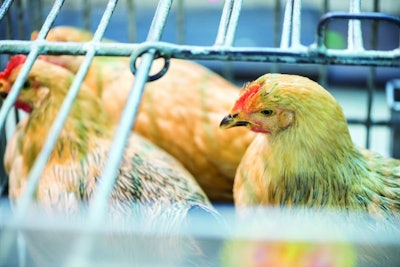
China’s poultry meat producers can look forward to little or no growth this year, but there may, at least, be some improvement in the industry’s margins.
The US Department of Agriculture’s Foreign Agriculture Service (FAS) estimates that poultry meat production will reach 14 million metric tons. Consumption is forecast to rise, and the market will undergo change, but while some sectors of the market will benefit, others will suffer.
White vs. yellow feather
Over the first eight months of 2022, the country’s poultry flock is thought to have declined by 10%. Production of white feather broilers is forecast to grow this year, while that of their more expensive yellow feather counterparts is predicted to continue declining.
Less favorable economic conditions will lead consumers to increasingly seek out meat from cheaper-to-produce white birds. Alongside this, purchasing yellow feather birds will continue to be constrained as ongoing COVID-19 restrictions make accessing live bird markets difficult.
Poultry meat consumption is, however, forecast to rise by 1% this year, and numerous factors will contribute to this.
Poultry meat consumption
FAS notes that since the 2018 outbreak of African Swine Fever and the consequent increase in pork prices, Chinese consumers have incorporated larger amounts of poultry meat into their diets. Pork prices may now have come down, but the transition to eating greater volumes of poultry meat appears to be continuing.
Local sources suggest that chicken will also continually take market share from other animal proteins, accounting for an ever-greater proportion of all meat consumption in China.
This may, in part, be due to improved processing technologies and greater availability of ready-to-eat products in addition to simply cost and availability.
Institutional clients are also incorporating more poultry meat into their offerings, however, ongoing restrictions on large gatherings in China have seen demand destruction in some sectors.
Many poultry producers and processing plants are reported to have been operating at a loss since 2021, but margins are expected to gradually improve as 2023 progresses before settling higher.
Feed costs in China, as in the rest of the world, have risen, and output declined over the first eight months of 2022. Lower-cost, higher volume broiler producers have been better able to absorb these costs than their smaller competitors.
China’s poultry meat imports to rise
Imports are expected to rebound to 750,000 MT this year, but further increases could be constrained by outbreaks of highly pathogenic avian influenza (HPAI) in exporting markets.
Importantly, the import of grandparent stock genetics remains uncertain due to HPAI restrictions. Rabobank notes that such restrictions will favor local genetics companies, able to fill the gap and increase market share, making China less reliant on imports.
China’s chicken production to contract in 2022





.jpg?auto=format%2Ccompress&fit=crop&h=167&q=70&w=250)












